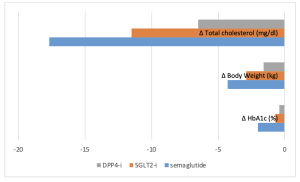Background: Oral semaglutide is the only available oral formulation of GLP1-RA which was effective and safe in clinical trials program focused on people with type 2 diabetes. Aim: To evaluate the effectiveness of oral semaglutide in clinical practice, compared with the other two major class of oral glucose-lowering medications, SGLT2-inhibitors (SGLT2-i) and dipeptidylpeptidase-4 inhibitors (DPP4-i). Methods: This retrospective study evaluated baseline characteristics and the change of glyco-metabolic parameters of patients starting oral semaglutide (n=48), or SGLT2-I (n=72) or DPP4-I (n=82), during the 3-12 months follow-up. At baseline, patients were on therapy with metformin, insulin, SGLT2-I and DPP4- differently combined. In the comparator groups, patients on oral dual therapy or on therapy with injectable GLP1-RAs were excluded. Results: At baseline patients initiated on oral semaglutide were younger, had shorter diabetes duration, higher HbA1c level and BMI than patients of other two groups. After a median follow-up of 10 months, patients treated with semaglutide showed changes in fasting blood sugar (mean change within group 30 mg/dL, p<0,001), HbA1c (mean change within group -2%, p<0,001), BMI (mean change within group -1,5 kg/m2, p<0,001), total cholesterol (mean change within group -17,7 mg/dl, p=0,01), HDL (mean change within group + 2,3 mg/dl, p=0,02), LDL (mean change within group – 21,6 mg/dl, p<0,001), triglycerides (mean change within group -35,8 mg/dl, p<0,001). Only 30% of patients were taking the maximum dose (14 mg) of semaglutide. Greater change in HbA1c, body weight and total cholesterol was achieved with semaglutide compared to SGLT2-i or DPP4-i. Conclusions: In the clinical practice, oral semaglutide is administered to middle aged adults, with a short diabetes duration and poor glucose control, providing an effective improvement of the diseases control. Fig. 1. Changes in HbA1c, body weight and total cholesterol.

Figure 1. Changes in HbA1c, body weight and total cholesterol.

